The scam of beauty
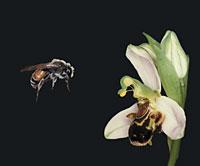
The orchids are the most beautiful of the plants. At least they fascinate insects. One of the petals of the flower has been completely distorted and thanks to this evolution, despite being plants, they have typical forms of the animal kingdom. Several orchids perform imitation of female insects in a state of unconcern, almost perfect imitation. And what insects do not become sharper after receiving an invitation to sex?
However, behind these invitations there is fraud. The male insect, when it approaches to cover the female, perceives something rare. There is no way to cover that female! Try and try it, but don't! Caught, he goes looking for a real female, since he has realized that these orchid joys have put his hair back on him.
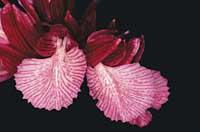
The orchid, however, has no reason to worry. Although this time he has lied to him, he knows that the next time the innocent insect will fall back into his net by sexual desire.
At the peak of evolution
Due to this surprising transformation of the petal, botanists claim that orchids are at the peak of vegetable evolution. Plants, in general, use colors and odors to attract insects and ensure pollination. But no one has developed such complex strategies as orchids, which have had to make great imitations to attract by sex.
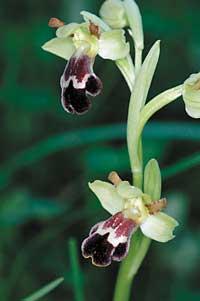
Biologist Javier Benito Ayuso has researched orchids for many years, and although his flowers still surprise him, he has one clear thing: “Complexity does not necessarily mean an evolutionary success. There are primitive plants and animals that for millions of years have not altered their appearance, precisely for their simplicity and adaptation to the environment, without need of change.”
However, no one questions the success of orchids. About 30,000 species of orchids are known in the world. It is a family that houses most of the plant species. The poles and deserts are the only areas on the planet where no orchids grow.
In the Basque Country there are more than eighty species. They live mostly on limestone lands, very frequent here. Therefore, many orchids are common in any margin of pathway, in any field. Yes, they are of reduced size, not as large as those of the tropical zones. In Benito's opinion, precisely that smallness gives them a special charm. Experts are aware of this and some orchids have been protected so that they are not served by people.
The antiquity of orchids has also provoked an intense debate among scientists. For many years it has been considered that having achieved such complex structures is to be expected to be among the most recent among all plants. “Now it is not so clear,” says Benedict. Some botanists believe that no. In fact, the fossil record of orchids is very small, and correspond to non-very ancient specimens, but it is possible that later older fossils appear. At the moment it is believed that older orchids are about 20 million years old.”
Under the domain of fungi
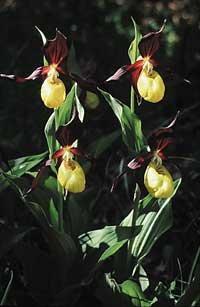
Despite having developed extremely complex strategies for pollination, orchids here have a great weakness: they live under the control of a fungus that lives on earth. In order to germinate, they need their help; if the fungus is not found, the seeds of the orchid cannot germinate. In fact, these are very special seeds, practically without reserve food, which are forced to supply fungi to the newborn glucose.
It is a very rare phenomenon, since the rest of plants have no such limitations. Normally each seed has enough food to germinate the new plant and feed until its initial development. The seeds of orchids, however, only contain the embryo and the surrounding surface.
This dependence of the fungus limits to a certain extent the extension of the plants, generating every year thousands of seeds to deal with the problem.
The most beautiful bee
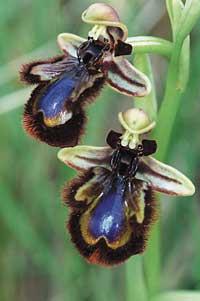
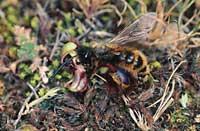
The orchid Ophrys speculum imitates with great precision the female bee with its hair. Scientists have seen that it has the same molecular structure as the bees' films. And by little, the flower smells of sexual hormones of bees. With all these tricks easily deceives the male bee and, as if it were real, try to cover it. Many times the sperm arrives even to pour on the flower.
He soon realizes that he has been sprayed and left, but by then the pollen that the orchid has left in a strategic place has been stuck in the back. And the flower will get what it wanted: pollination.
Some bees are totally promiscuous and bloom behind a real female. On sale they return home with the backrest full of pollen at the end of the day.
Food lie lie lie
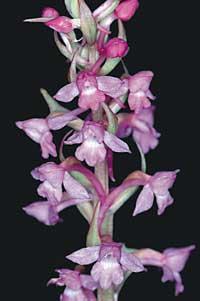
Not all orchids use sex to attract insects, food also serves. The gymnadenia conopsea preserves the nectar in the elongated organ called ezproi, but only below. This ensures that only the butterflies will take nectar with their long and winding tongue.
There are species tranpatías, orchids with empty spur. The smell of nectar of the internal cells makes the insects approach exactly the same. The pollen is stuck to the body. Yes, there is no trace of nectar!
Stop at night!
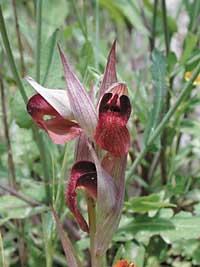
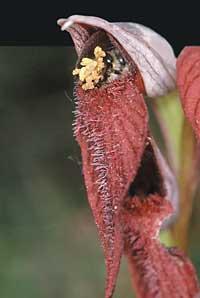
The genus Serapias has developed a curious strategy: it acts as a shelter of insects. With the flower it creates a kind of tube, and when it is cold, the small bees enter to spend the night, the next morning, until they leave with the sun. The bee of the photo ends the day with the head full of orchid pollen.
Men in miniature
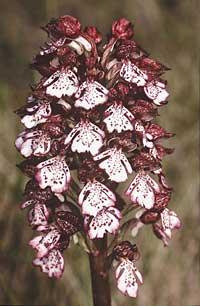
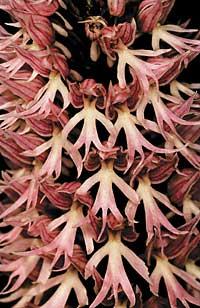
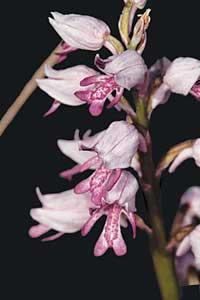
This incredible transformation of orchids into the labellum has led to many strange shapes. In some cases, chance has given them the appearance of human beings. Examples of this are the names of many orchids that grow in Euskal Herria: Orchis purpurea, for example, reminds a girl with dress (right photo). It is called “Orchid of Ladies”. Orchis militaris (on the left), however, has been taken as a man and is known as “military orchid”. Orchis italica (in the center) also looks like a little man, but unlike the previous one, before Orchis longicruris subsp. longipenis, that is, the “orchid of legs and long penises”.
“There are orchids that are authentic miniature filigrees”
The Rioja Javier Benito Ayuso knows perfectly the orchids of Euskal Herria. He has been many hours climbing and down the mountain in his quest. Yes, with the camera of photos in the coconut and always looking to the ground, looking for smaller and curious orchids. In fact, he is conducting a doctoral thesis on orchids in the Iberian Peninsula.
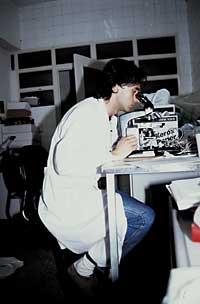
How did you start researching these incredible plants?
Studying Biology, the preferred topic was Botany and I decided to investigate the family of orchids. And they are so rare! Then I realized that, however special they may be, little has been investigated.
What has cost you most to photograph among all orchids?
The species Serapias perez chiscanoi has probably been the one that has given me the most work to find. I've spent a lot of time trying to get the picture. However, I have found several orchids, but I have not yet managed to get the photo that fills me.
And in general, what is the most appreciated orchids?
I think it is the species Cypripedium calceolus. Of all the orchids growing here is the highest flower, and its appearance and intense yellow color are wonderful. And then there are other orchids that appreciate a lot for their curious shapes. I, in general, the little ones are the ones I like the most, among them there are some who are authentic miniature filigrees.
Buletina
Bidali zure helbide elektronikoa eta jaso asteroko buletina zure sarrera-ontzian











